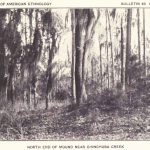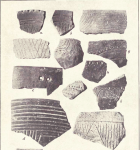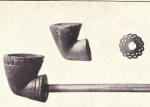Several mounds are found within the Bayou Lacomb area. The largest of these is situated about 200 yards north of the right bank of Chinchuba creek, and about 1½ miles in a direct line north of Lake Pontchartrain. The mound has an elevation of between 4 and 5 feet; it is circular in form and has an average diameter of approximately 90 feet.
A trench was run from near the center of the mound, extending northeast 47 feet and continuing beyond the edge of the artificial work. This was evidently a domiciliary mound. Two fire beds were discovered. The first (a), near the center of the mound, had a diameter of a trifle more than 2 feet; it was slightly concave in form and was situated at a depth of 15 inches below the surface of the mound. The second fire bed (b) was discovered near the edge of the artificial work, evidently on or near the original surface; this was similar to a in form, size, and situation, but sloped toward the northeast. Both fire beds showed evidence of considerable use. As a result of the heat, the earth was discolored to a depth of from 6 to 8 inches beneath the surface of the hearth, and to a depth of several inches it had become quite hard.
The mound was formed of a compact, homogeneous mass of clay and sand. There was practically no surface soil or vegetal mold, consequently it was not possible to trace the old sod line, and thus to distinguish the artificial from the natural formation.

A deposit of shells (c) was revealed a short distance from fire bed as shown in the drawing; this extended in a general direction from northwest to southeast and was examined for a distance of 10 feet. At the point of intersection by the trench the mass of shells lay from 4 to 4 feet below the surface of the mound. The width of the deposit was about 4 feet and its thickness 10 inches.
For reasons stated above, it was not possible to determine whether the shells rested upon the original surface or filled an artificial excavation. They appeared, however, to be below the original surface, as indicated on the drawing.
The shells were those of an edible clam (Rangia cunteata Gray) found in vast quantities in Lake Pontchartrain. Intermingled with the shells were quantities of bones of deer, rabbits, and alligators, 1 that had served as food, many having been broken open for the removal of the marrow. Fragments of many pottery vessels also were recovered, but no entire objects of any sort were found, nor was a single piece of stone discovered in any part of the excavation.

Examples of pottery from the shell deposit are shown in the following image.

Some of the pieces may be described as follows:
(a, b) Fragments of two vessels showing decoration on the inner, or concave, surfaces—a rather unusual form, probably similar to the shallow dish discovered by Moore in a mound on Black Warrior river, Alabama. 2 (c) Two pieces of a large vessel. These had evidently been held together by a cord or sinew passed through the two perforations and tied. The fracture between the perforations occurred while the vessel was still in use. (d) A fragment of a very large and exceptionally well decorated vessel. The straight upper edge of this piece measures 3 inches. By measurement the curvature of the rim shows the vessel to have been between 23 and 24 inches in diameter. The color is dark gray; the surface is very smooth and polished. The decoration was probably incised after the clay was dry, but before the vessel was fired. Smaller fragments of the same vessel were also discovered. (e) Small fragment of a rim of a rather large vessel, having a perforated projection through which a cord was probably passed. (f) A conventionalized form of (e) showing a projection, but no longer perforated.
Although some of the pieces represent jars and vessels of exceptionally good workmanship, the majority appear to have been rather crudely made and decorated. Both straight and curved lines appear in the ornamentation; these were evidently added after the clay had become dry. But the pits in specimens g, h, and i clearly were made while the material was in a plastic state.
All the pottery shows a tempering of finely pulverized shell.
The pipe (a) was the most interesting object found in the shell deposit. According to Mr. J. D. McGuire, this belongs to the oldest type of pipe found in the lower Mississippi valley; under his classification it is of the biconical form, similar to the modern Choctaw pipes shown in the following image.

The maximum diameter of the bowl is 13/8 inches; it is rather shallow, being only 7/8 of an inch deep.
As has already been stated, no examples of stone objects were discovered in the mound, although these are found in the surrounding country.

A piece of indurated clay (b), however, showing evidence of having been used, probably as a smoother, was unearthed in the deposit of shells. Typical examples of stone objects are represented on the same plate, namely: four points (c, d, e, f) found a short distance south of the mound; two scrapers (g, i) made of red jasper, found on the surface south of the mound; a jasper bead (h) having a biconical perforation; and three pieces, k, 1, m, found on the shore of Lake Pontchartrain. A high polish has resulted from the action of the sand and water. Arrow points of white quartzite have also been found in the locality, but these were probably made far to the northeast. Small grooved axes are likewise met with, but they are quite rare. The jasper of which the specimens figured were made was obtained in the form of pebbles from the beds of certain streams in St. Tammany parish.
South and east of the mound referred to above, for a distance of 200 feet or more, the surface was covered with shells of the kind mentioned (Rangia cuneata Gray) to a depth of from 4 to 8 inches. Intermingled with the shells were fragments of pottery and traces of bones, greatly decayed. A similar deposit was encountered on the opposite side of Chinchuba creek, near the great live oak commonly called “Père Rouquette’s oak” (p1. 6). Some shells and a few pieces of pottery were found exposed upon the surface beneath the branches of the oak, on the very spot where the Choctaw were wont to gather to hear the teachings of Père Rouquette. These latter examples of pottery and likewise the shells appear to be of comparatively recent origin, and were undoubtedly left there by the Choctaw not more than one or two generations ago. As the pottery is similar to that found in the deposit of shells beneath the mound, all should probably be attributed to the same people.
Several burials are said to have been discovered in a low mound a short distance west of the Chinchuba mound. The work is reputed to have been done some years ago; but the writer was unable to gain any definite information respecting it.
Citations:
- These were identified by Dr. M. W. Lyon, Jr., of the U.S. National Museum, to whom the writer desires to express his indebtedness.[
]
- Clarence B. Moore, Certain Aboriginal Remains of the Black Warrior River, fig. 92, p. 192, Philadelphia, 1905.[
]
